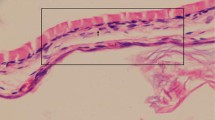Abstract
The objective of the study is to determine whether topical halofuginone (HF) application has an impact on prolonging the time for healing of myringotomy incision, and to investigate histopathologic effects of HF on tympanic membrane (TM) in rat model. Forty rats with normal eardrums were involved in this study. The study group and control group consisted of 30 and 10 rats, respectively. A posterior incision 1 mm in diameter was made on healthy eardrums of the rats. Following incision, gelfoam soaked with HF hydrobromide of 30 mg/dl was applied on the perforation in study group, whereas gelfoam soaked with isotonic saline was applied on the perforation in control group. On days 1, 3, 7, 10, 14, 18, 21, 24, 27, and 30, otoendoscopic evaluation of eardrums under general anesthesia was conducted and perforations were screened. A rat of each group was killed in control days and TMs were dissected to evaluate histopathological changes. The average times for patency of perforation in study and control groups were 21.43 and 7.50 days, respectively. The difference was found to be statistically significant (p < 0.05). Histopathological evaluation revealed that HF reduces hyalinisation and fibrosis in eardrum, when compared with the control group. In conclusion, HF significantly delays closure time of myringotomies in rat model. However, this delay may not be enough for recovery of otitis media with effusion.

Similar content being viewed by others
References
Paparella MM, Schachern P (1994) New developments in treating otitis media. Ann Otol Rhinol Laryngol Suppl 163:7–10
Cohen D, Siegel G, Krepsi J, Schechter Y, Slatkine M (1998) Middle ear laser office ventilation (LOV) with a CO2 laser flash scanner. J Clin Laser Med Surg 16(2):107–109
Goode RL, Schulz W (1982) Heat myringotomy for the treatment of serous otitis media. Otolaryngol Head Neck Surg 90(6):764–766
Cincik H, Gungor A, Cekin E et al (2005) Effects of topical application of mitomycin-C and 5-fluorouracil on myringotomy in rats. Otol Neurotol 26:351–355
Arbell D, Udassin R, Koplewitz BZ, Ohana M, Genina O, Pines M, Nagler A (2005) Prevention of esophageal strictures in a caustic burn model using halofuginone, an inhibitor of collagen type I synthesis. Laryngoscope 115:1632–1635
Nagler A, Genina O, Lavelin I, Ohana M, Pines M (1999) Halofuginone, an Inhibitor of collagen type I synthesis, prevents postoperative adhesion formation in the rat uterine horn model. Am J Obstet Gynecol 180(3 Pt 1):558–563
Pines M, Knopov V, Genina O, Lavelin I, Nagler A (1977) Halofuginone, a specific inhibitor of collagen type I synthesis, prevents dimethylnitrosamine-induced liver cirrhosis. J Hepatol 27(2):391–398
Nagler A, Pines M (1999) Topical treatment of cutaneous chronic graft versus host disease (cGvHD) with halofuginone: a novel inhibitor of collagen type I synthesis. Transplantation 68:1806
Nagler A, Firman N, Feferman R, Cotev S, Pines M, Shoshan S (1996) Reduction in pulmonary fibrosis in vivo by halofuginone. Am J Respir Crit Care Med 154:1082–1086
Nyska M, Nyska A, Rivlin E, Porat S, Pines M, Shoshan S, Nagler A (1996) Topically applied halofuginone, an inhibitor of collagen type I transcription reduces peritendinous fibrous adhesions following surgery. Connect Tissue Res 34(2):97–103
Nagler A, Rivkind AI, Raphael J, Levi-Schaffer F, Genina O, Lavelin I, Pines M (1998) Halofuginone—an inhibitor of collagen type I synthesis—prevents postoperative formation of abdominal adhesions. Ann Surg 227(4):575–582
Ertugrul EE, Cincik H, Dogru S, Cekin E, Berber U, Güngör A, Poyrazoğlu E (2007) Effect of halofuginone on fibrosis formation secondary to experimentally induced subglottic trauma. Laryngoscope 117(2):299–302
Halevy O, Nagler A, Levi-Schaffer F, Genina O, Pines M (1996) Inhibition of collagen type I synthesis by skin fibroblasts of graft versus host disease and scleroderma patients: effect of halofuginone. Biochem Pharmacol 52(7):1057–1063
Gailit J, Clark R (1994) Wound repair in the context of extracellular matrix. Curr Opin Cell Biol 6(5):717–725
Ruckley RW, Blair RL (1988) Thermal myringotomy (an alternative to grommet insertion in childhood secretory otitis media?). J Laryngol Otol 102(2):125–128
Koopman JP, Reuchlin AG, Kummer EE, Boumans LJ, Rijntjes E, Hoeve LJ, Mulder PG, Blom HM (2004) Laser myringotomy versus ventilation tubes in children with otitis media with effusion: a randomized trial. Laryngoscope 114(5):844–849
Estrem SA, Baker TJ (2000) Preapplication of MMC for enhanced patency of myringotomy. Otolaryngol Head Neck Surg 122(3):346–348
Conflict of interest statement
The authors declare that they have no conflict of interest.
Author information
Authors and Affiliations
Corresponding author
Rights and permissions
About this article
Cite this article
Ozdemir, T., Cincik, H., Dogru, S. et al. Efficacy of topical halofuginone in myringotomy patency. Eur Arch Otorhinolaryngol 267, 1701–1704 (2010). https://doi.org/10.1007/s00405-010-1306-z
Received:
Accepted:
Published:
Issue Date:
DOI: https://doi.org/10.1007/s00405-010-1306-z




